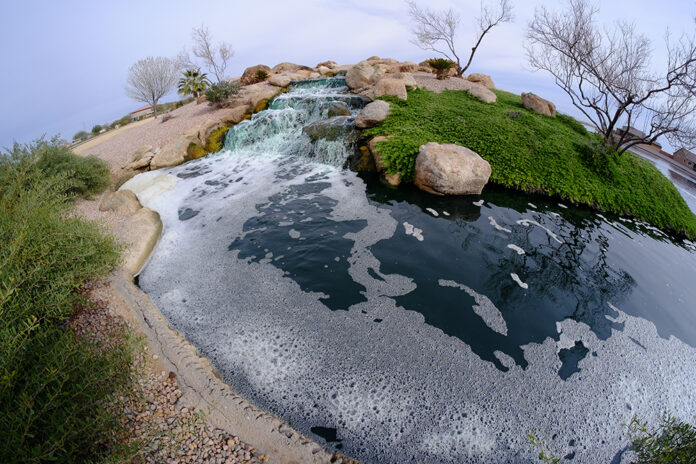
Maricopa’s future looks solid because of water.

“Global Water has a really great supply,” said Jake Lenderking, Global Water Resources’ director of Water Resources. “They have a designation of an assured supply for our service area and for growth in our service area.”
Lenderking said the company has solid groundwater and recycled water storage. Because Maricopa is a relatively new city, Global has been able to design a unique and efficient water delivery and sewer system.
The model is called Total Water Management.
“They were able to build this in from day one in new developments. It is essentially the reuse,” he said. “We look at water as in integrated resource. We’re not just saying that we’re a water utility. We are a water utility, we are a wastewater utility and we’re a recycled water utility.”
Also in the series Drought & Development
Overview
Councilman gives Arizona 30 years left to survive
O’Halleran: Drought means no shortage of water issues
Contingency plan bites into Pinal County agriculture
Lenderking said an old water utility may serve a half-acre foot of per connection. With Total Water Management, Global was able to go into Maricopa with new plumbing codes that allows for 1.6 gallon per flush toilets and other water saving measures.
“All of this is pretty much throughout Maricopa,” Lenderking said. “So, we won’t be at 0.5; we will be at less. We also use recycled water everywhere we can. It actually reduces our reliance on our source water.”
“The sustainable path is ground water and recycled water for quite a long time,” he said.
Lenderking said in Arizona there is a program called the Assured Water Supply Program and the Arizona Department of Water Resources.[quote_box_right]“We have the right to pump the groundwater beneath us. To say that it is there for 100 years, we had to actually prove through groundwater modeling that it exists. That water is there.”[/quote_box_right]
“As a landowner or certain water utilities, like us,” Lenderking said, “you have to prove to the Department of Water Resources that you have a 100-year assured supply. When you prove that, you get a certificate or like here in Maricopa we went and got a designation under the utilities and the landowner doesn’t have to prove it. We have it for our whole service area that we have 100 years of assured supply.”
He said this means Global Water can serve an adequate amount of water to Maricopa, year after year for 100 years.
The Department of Water Resources has tested Global Water’s physical ability to deliver water, legal ability, continuous water supply availability, water quality, consistency, their management plan and financial capabilities.
“We have the right to pump the groundwater beneath us. To say that it is there for 100 years, we had to actually prove through groundwater modeling that it exists. That water is there,” he said.
Lenderking said even though the state looks at a 100-year supply, the system works like a permit and companies like Global Water has to re-prove their models to the state.
He said they have proved up 22,914-acre feet of water and “we use a little less that 7,000-acre feet per year here in Maricopa. We have over three times what we use today to grow on and then than number, 22,914 to use year after year for 100 years. We have a very good and sustainable water supply,” said Lenderking.
He said there are a series of water basins in the area. Maricopa sits over the Maricopa/Stanfield Sub-Basin. Next door to the east is the Eloy Sub-Basin near Eloy, Casa Grande and Florence. Often the two sub-basins are paired because they are hydrologically connected.
“Our (sub-basin) is huge and vast. There are millions and millions of acre feet of water in storage,” Lenderking said.
He said the natural and artificial recharge of the two sub-basins does not stack up to the amount of water being taken out of the aquifers annually.
“We have agricultural, dairies, municipal use and some industrial use all having straws in that aquifer,” Lenderking said.
With a 512,000-acre foot reduction possible in Arizona under the DCP, municipal supplies like Global Water won’t be seriously impacted. Most cuts will come to the Ag industry when DCP is implemented.
“There are people who worked on DCP every day for the past couple of years,” Lenderking said. “There’s that many details. Right now, the irrigation districts do pump quite a bit of groundwater. That’s going to increase because of surface water reduction. How much of that makes sense for them? It’s up to them and they’re working with that. They are grappling with what is the right number.”
Lenderking said adding groundwater to the irrigation system costs more money, so it has an upfront cost to the irrigation district.
“Then you have a what do you want to do situation. Do you want to pump all the water out of the aquifer in 60 years or do you want to save some for 200 years?” Lenderking said.
He said he is concerned about how much water will be pumped out of the aquifer looking at a long term usage but he said he has no concern about what their pumping right now.
“We’re actually in a really nice place here in Maricopa, geographically on the aquifer. With the Gila Indian River community to the north and virtually no ground water uses and the Ak-Chin Indian Community around us and to the south.”
He said the two Native American communities will still be importing Colorado River surface water and not pumping groundwater, protecting the aquifer.
“Between the two, we don’t have a lot of groundwater mining right here,” Lenderking said.
He said much more groundwater is being mined south of the Ak-Chin Community by ag producers.
[pull_quote_left]”We should try to get our ducks in a row. We know we have water here, but people have been fighting about it. It has created some negative economic development issues.”[/pull_quote_left]Lenderking said Maricopa will be able to handle quite a bit of growth based on the water supply.
“There will be long-term water planning projects that will continue to augment water supplies,” he said. “There are provisions for that written into laws and treaties with Mexico.”
Population estimates projecting the growth of Maricopa range from 161,000 to 300,000 by the year 2050.
“We are using about a third of what our designated supply has in it. We’re 51,000 now in Maricopa. It almost pairs perfectly with the population growing by three times and three times the water use. That is a good fit. We will be renewing that designation, assured supply and adding to it as needed,” Lenderking said.
Water is an important issue in Arizona.
“I think there is an article in a national paper every other week. There’s an article in our papers at least every week. In Arizona probably, everyday there’s an article about drought or shortage. I think it has a pretty negative impact. We should try to get our ducks in a row. We know we have water here, but people have been fighting about it. It has created some negative economic development issues,” Lenderking said.






![MHS G.O.A.T. a ‘rookie sleeper’ in NFL draft Arizona Wildcats wide receiver Jacob Cowing speaks to the press after a practice Aug. 11, 2023. [Bryan Mordt]](https://www.inmaricopa.com/wp-content/uploads/2024/04/cowing-overlay-3-218x150.png)





![Alleged car thief released without charges Phoenix police stop a stolen vehicle on April 20, 2024. [Facebook]](https://www.inmaricopa.com/wp-content/uploads/2024/04/IMG_5040-218x150.jpg)




